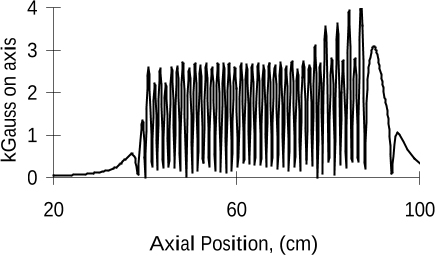




Did you find this useful? Give us your feedback










20 citations
20 citations
13 citations
10 citations
9 citations
246 citations
...EGUN[1] simulations were performed (Fig....
[...]
The lossy drift tube material may serve to dampen possible trapped oscillations and any coupling between the gun, cavities and collector.
The rf circuit is adapted to the lower perveance beam by increasing the cavity spacings, altering tunings, and adding an extra cell in the traveling-wave output structure for a total of 5 cells.
There are also areas of beam instability in PPM focused tubes and the possibility of coupling to modes which grow from an undulating beam.
Replacing the gun coil forced large peak-to-peak variations in the field strength design on axis, and switching to bulk NdFeB resulted in a loss of control in material quality.
The beam-tester processing began with a 1 µs beam pulsewidth and proceeded up to 490 kV, 5 % above the design point, without incident.
When operated in the confined-flow condition the high-convergence gun design has 50 % of the beam flux threading the cathode (as measured at the axis).
The design philosophy of the beam-tester was to eliminate all sources of trouble that could interfere with a study of the PPM beam formation andtransmission.
Periodic Permanent Magnet (PPM) focusing is utilized in Traveling-Wave Tube (TWT) devices for commercial and military applications.
The three adjustment coils near the anode had negligible effect on the transmission data but one of the coils had a visible effect on the rising and falling edges of the collector current pulse.
The drawback with PPM focusing is that the construction complexity of the tube may be increased so construction costs and failure rates could rise.
As such, hollow beams are a direct result of the gun design parameters in most high-power klystrons due to limitations in the possible emission current density of today’s cathode materials for long-life.
Due to the high energy-products required for the magnets combined with geometrical constraints, it is usually not possible to thread as much flux through the cathode as it is with solenoidal focusing so particular attention must be paid to the gun design and beam transport issues.
Despite the difficulties, gain was found to be between 55 and 60 dB and efficiency measured 60 % at the saturated rf output level of 70 MW.
It is difficult to get large confinement ratios with PPM focusing because the pole pieces eventually saturate and magnetic materials have finite strengths.
Since the high voltage beam pulse has a finite rise and falltime, then a portion of the beam pulse is below the stopband and interception occurs.